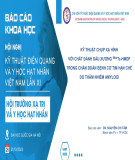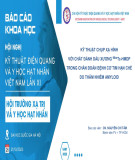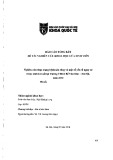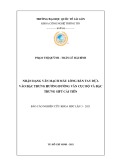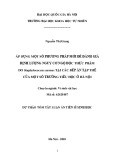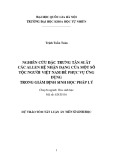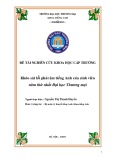
RESEARCH Open Access
Expression and prognostic significance of
cancer-testis antigens (CTA) in intrahepatic
cholagiocarcinoma
Jin-xue Zhou
1†
, Yin Li
2†
, Sun-xiao Chen
3*
, An-mei Deng
3*
Abstract
Background: Cancer-testis antigens (CTAs) are suitable targets for cancer-specific immunotherapy. The aim of the
study is to investigate the expression of CTAs in intrahepatic cholagiocarcinoma (IHCC) and evaluate their potential
therapeutic values.
Methods: Eighty-nine IHCC patients were retrospectively assessed for their expression of CTAs and HLA Class I by
immunohistochemistry using the following antibodies: MA454 recognizing MAGE-A1, 57B recognizing multiple
MAGE-A (MAGE-A3/A4), E978 recognizing NY-ESO-1, and EMR8-5 recognizing HLA class I. The clinicopathological
and prognostic significance of individual CTA markers and their combination were further evaluated.
Results: The expression rates of MAGE-A1, MAGE-A3/4 and NY-ESO-1 were 29.2%, 27.0% and 22.5%, respectively. The
concomitant expression of CTAs and HLA class I antigen was observed in 33.7% of the IHCC tumors. We found that
positive MAGE-3/4 expression correlated with larger tumor size (≥5 cm), tumor recurrence and poor prognosis.
Moreover, we identified 52 cases (58.4%) of IHCC patients with at least one CTA marker expression, and this
subgroup displayed a higher frequency of larger tumor size and a shorter survival than the other cases. Furthermore,
expression of at least one CTA marker was also an independent prognostic factor in patients with IHCC.
Conclusion: Our data suggest that specific immunotherapy targeted CTAs might be a novel treatment option for
IHCC patients.
Introduction
Intrahepatic cholagiocarcinoma (IHCC) is a relatively
uncommon malignancy, comprising approximately 5%-
10% of the liver cancers, and both its incidence and
mortality have increased in recent years in China and
other countries [1,2]. IHCC is not sensitive to radiation
therapy and chemotherapy. Even the patients under-
going a radical surgical resection is still at a high risk
for early recurrence, and the patients’survival is thus
unsatisfactory. Therefore, there is a great need to iden-
tify molecular targets for developing novel therapeutic
approaches for patients with IHCC.
Cancer testis antigens (CTAs) comprise a group of
non-mutated self-antigens selectively expressed in
various tumors and normal testis tissues, but not in
other normal tissues [3]. Several studies have shown
that if presented with human leukocyte antigen (HLA)
class I molecules, these tumor-associated antigens could
induce effective anti-tumor cytotoxic T lymphocytes
(CTLs) response in vitro and in vivo [4]. Because of
these unique characteristics, CTAs are regarded as pro-
mising targets for cancer-specific immunotherapy [5].
However, the possibility that IHCC patients might bene-
fit from CTA-targeted therapies has not been evaluated.
Given their potential therapeutic significance, it may
have significance for exploring the presence of CTAs in
IHCC. However, to our knowledge, until now, only two
studies examined the mRNA and protein expression of
CTAsinsmallnumberofIHCCcases[6,7].TheCTAs
expression at protein level and their clinicopathological
and prognostic significance in a larger cohort have not
been investigated.
* Correspondence: chensunxiao@126.com; anmeideng@yahoo.com.cn
†Contributed equally
3
Changzheng Hospital, Second Military Medical University, Shanghai 200003,
PR China
Full list of author information is available at the end of the article
Zhou et al.Journal of Experimental & Clinical Cancer Research 2011, 30:2
http://www.jeccr.com/content/30/1/2
© 2011 Zhou et al; licensee BioMed Central Ltd. This is an Open Access article distributed under the terms of the Creative Commons
Attribution License (http://creativecommons.org/licenses/by/2.0), which permits unrestricted use, distribution, and reproduction in
any medium, provided the original work is properly cited.

The aims of the current study were to analyze the
expression of MAGE-A1, MAGE-A3/4 and NY-ESO-1
CTAs in IHCC tissues by immunohistochemistry, and
to investigate correlations between their expression with
HLA class I expression, clinicopathologic parameters
and survival in patients with IHCC.
Materials and methods
Patients
The study was approved by the research ethics commit-
tee of our institutions, and informed consent was
obtained from each patient. A total of consecutive 102
patients with IHCC who underwent curative resection at
Department of Hepatobiliary and Pancreatic Surgery,
Henan Tumor Hospital (Zhengzhou, China) and Changz-
heng Hospital (Shanghai, China) from 1999 to 2006 were
retrospectively reviewed. Patients with lymphnode-posi-
tive metastasis routinely received 5-fluorouracil-based
chemotherapy, and Gemcitabone chemotherapy was
given when recurrence occurred. Patients were followed
up every two month during the first postoperative year
andateveryfourmonthafterward.Follow-upwasfin-
ished on May 2008. The median follow-up was 24 month
(range, 4-61 month). Overall survival (OS) time was
defined as the time from operation to cancer-related
death only.
Cases were included according to the following
inclusion criteria: having archived formalin-fixed, paraf-
fin-embedded specimens available; having complete
clinicopathological and followed-up data; receiving no
anticancer treatment before operation. Patients who
died of unrelated diseases and within one month after
operation were excluded, leaving 89 patients eligible for
this analysis. The clinical and pathological details of
these patients were summarized in Additional file 1.
Immunohistochemical analysis
Immunohistochemical analysis was performed on
archived tissue blocks containing a representative
fraction of the tumors. Briefly, 5-μm-thick paraffin-
embedded tissue sections were deparaffinized and
rehydrated. Endogenous peroxidase was blocked with
methanol and 0.3% H
2
O
2
for 20 min. Antigen retrieval
was performed with microwave treatment in 0.1 M
sodium citrate buffer (pH 6.0) for 10 min. Expression of
CTAs was detected with the monoclonal antibody
against MAGE-A1 (clone MA454), MAGE-A3/4 (clone
57B) and NY-ESO-1 (clone E978), as described pre-
viously [8-10]. Clone 57B was originally raised against
MAGE-A3, and later has been reported to primarily
recognize the MAGE-A4 antigen [11,12]. Currently, 57B
is considered to be anti-pan-MAGE-A (MAGE-A3/4).
Expression of HLA class I was detected with an anti-
pan HLA class I monoclonal antibody EMR8-5, as
described previously [13]. Detection was performed with
the Dako Envision system using diaminobenzidine
(DAB) as the chromogen. Non-specific mouse IgG was
used as negative control and normal human testis tis-
sues were used as positive controls for CTA expression.
Immunochemical results were evaluated and scored by
two and independent observers according to the pre-
vious criteria [14]. Positive CTA expression was assigned
to any extent of immunostaining in sections and further
graded into four groups: + : < 5% of tumor cells stained;
++ : 5-25% of tumor cells stained; +++ : > 25-50% of
tumor cells stained; ++++ : > 50% of tumor cells
stained. A patient was considered CTA-positive if at
least one of three markers demonstrated positive immu-
noactivity. HLA class I expression was classified as posi-
tive and down-regulated compared with stromal
lymphocytes as an internal control as previously
described [13].
Statistical analysis
The associations between CTAs expression and clinico-
pathological parameters were evaluated using Chi-square
or Fisher’s exact test, as appropriate. Overall survival of
patients were estimated by the Kaplan-Meier method,
differences between groups were compared were by the
log-rank test. Multivariate analysis was performed using
a Cox proportional hazard model. Statistically significant
prognostic factors identified by univariate analysis were
entered in the multivariate analysis. All the statistical
analyses were performed with SPSS 16.0 software.
P value less than or equal to 0.05 was considered statis-
tically significant.
Results
Expression of MAGE-A1, MAGE-A3/4, NY-ESO-1 and HLA
class I proteins in IHCC patients by
immunohistochemistry
MAGE-A1, MAGE-A3/4 and NY-ESO-1 showed a pre-
dominantly, although not exclusively, cytoplasmic
staining (Figure 1). The frequency and grade of various
CTA expressions in tumors is shown in Table 1. Fig-
ure 2 showed a Venn diagram dipicting the overlap of
three CTAs expression. When the CTA combinations
were tested, 52 from 89 IHCC cases (58.4%) showed
expression of at least one marker, 14 cases (15.7%)
demonstrated co-expression of two CTAs, and only
three cases (3.3%) were positive for all the three anti-
gens. As seen in table 2, down-regulated HLA class I
expression was found in 42.7% of all tumors (n = 38).
Comparing the relationship between individual or
combined CTAs expression and HLA-class I expres-
sion, no correlation was observed. And 30 IHCC cases
(33.7%) demonstrated concomitant expression of CTAs
and HLA class I antigen.
Zhou et al.Journal of Experimental & Clinical Cancer Research 2011, 30:2
http://www.jeccr.com/content/30/1/2
Page 2 of 6

Correlation between CTAs expression with HLA-class I
expression and clinicopathological parameters
We found that positive MAGE-A3/4 and one CTA mar-
ker expression were detected more frequently in tumors
with bigger size (≥5 cm) (20/24, 38/52), than in smaller
tumors (P = 0.011, P = 0.009). In addition, MAGE-A3/4
positive IHCC had a higher recurrence rate (17/24) than
negative subgroup (30/65, P = 0.038). There was no sta-
tistically significant correlation found between individual
or combined CTA expression and any other clinico-
pathological traits.
Correlation between CTAs expression and overall survival
The correlation of clinicopathological parameters and
individual or combined CTA expression with overall
survival was further investigated. As shown in Table 3,
univariate analysis showed that overall survival signifi-
cantly correlated with TNM stage, lymphnode metasta-
sis, resection margin, differentiation and tumor
recurrence but not with gender, age, tumor size and
number, vascular invasion and perineural invasion.
Patients with MAGE-A3/4 positive tumors had a signif-
icantly poorer outcome compared to those without
MAGE-A3/4 expression. MAGE-A1 and NY-ESO-1 also
demonstrated the same trend but did not reach statistical
significance. Interestingly, negative expression in all
CTAs correlated with a better prognosis than at least one
CTAs expression, meanwhile, two or three CTAs expres-
sion had no impact on survival (Figure 3, Table 3). COX
proportional hazard model analysis showed that at least
one CTA expression was an independent prognostic indi-
cator for IHCC, whereas the association of MAGE-A3/4
Figure 1 Immunohistochemical analysis of MAGE-A1, MAGEA3/
4, NY-ESO-1 and HLA Class I in intrahepatic cholagiocarcinoma.
Sections were stained with antibody against (A) MAGE-A1 (MA454);
(B) MAGE-A3/A4 (57B); (C) NY-ESO-1 (E978); (D) HLA Class I (EMR8-5).
Table 1 Expression of cancer-testis antigens in
intrahepatic cholanglocarcinoma
MAGE-A1 N (%) MAGE-A3/4 N (%) NY-ESO-1 N (%)
Negative 63 (70.8) 65 (73.0) 70 (78.7)
Positive 26 (29.2) 24 (27.1) 19 (21.3)
+ 2 (2.2) 1 (1.1) 1 (1.1)
++ 3 (3.4) 4 (4.4) 1 (1.1)
+++ 12 (13.5) 14 (15.7) 7 (7.9)
++++ 9 (10.1) 5 (5.6) 10 (11.2)
Figure 2 Venn diagram depicting the overlap in the expression
of cancer-testis antigens in intrahepatic cholagiocarcinoma.
Table 2 Correlation between CTA expression pattern and
HLA class I expression
CTA expression pattern HLA class I expression P value
Positive
(n = 51)
Down-regulated
(n = 38)
MAGE-A1
Positive 18 8 0.144
Negative 33 30
MAGE-A3/4
Positive 11 13 0.184
Negative 40 25
NY-ESO-1
Positive 11 8 0.953
Negative 40 30
1 CTA positive
With 30 22 0.930
Without 21 16
2 CTA positive
With 9 5 0.565
Without 42 33
3 CTA positive
With 1 2 0.795
Without 50 36
Zhou et al.Journal of Experimental & Clinical Cancer Research 2011, 30:2
http://www.jeccr.com/content/30/1/2
Page 3 of 6

with a shorter survival failed to persist in the multivariate
analysis (Table 4).
Discussion
In this study, expression of three CTAs at protein level
was investigated by immunohistochemistry. MAGE-A1,
MAGE-A3/4 and NY-ESO-1 were selected considering
that these antigens have been well-accredited and are
being applied for clinical trials of vaccine immunother-
apy [15-18]. The expression frequency of CTAs varies
greatly in different tumors type [19,20]. Our results
showed that expression rates of MAGE-A1, MAGE-A3/
4 and NY-ESO-1 in IHCC were less than 30%. Accord-
ing to the established criteria [21], IHCC should be
classified to be low “CTA expressors”.Inaprevious
study, the expression rates of MAGE-A1, MAGE-A3
and NY-ESO-I in IHCC were 20.0% (4/20), 20.0% (4/20)
and 10.0% (2/20) detected by RT-PCR [6]. However, in
the immunohistochemical study by Tsuneyama et al. [7],
32 of 68 IHCC cases (47.1%) demonstrated positive
MAGE-A3 expression using a polyclonal antibody.
Table 3 Univariate analyses of prognostic factors
associated with overall survival (OS)
Variable Category No. of patients P
Gender female vs. male 31 vs. 58 0.587
Age < 60 vs. ≥60, years 19 vs. 70 0.532
TNM stage 1/2 vs. 3/4 34 vs. 55 0.007
Tumor size ≥5 cm vs. < 5 cm 55 vs. 34 0.690
Differentiation well or mod vs. poor 26 vs. 63 0.008
Resection margin R0 vs. R1/2 56 vs. 33 0.008
Tumor number single vs. multiple 58 vs. 31 0.385
Vascular invasion with vs. without 42 vs. 47 0.227
Perineural invasion with vs. without 33 vs. 56 0.736
Lymph node metastasis with vs. without 38 vs. 51 0.001
Tumor recurrence with vs. without 47 vs. 42 0.022
MAGE-A1 Positive vs. negative 26 vs. 63 0.116
MAGE-A3/4 Positive vs. negative 24 vs. 65 0.009
NY-ESO-1 Positive vs. negative 19 vs. 70 0.068
1 CTA positive with vs. without 52 vs. 37 0.001
2 CTA positive with vs. without 14 vs. 75 0.078
3 CTA positive with vs. without 3 vs. 86 0.372
Figure 3 Correlation between individual or combined CTA expression and survival. Kaplan-Meier survival curves performed according to
CTAs expression.(A) MAGE-A1; (B) MAGE-A3/4; (C) NY-ESO-1; (D) at least one CTA positive; (E) two CTAs expression; (F) with three CTAs expression.
Table 4 Multivariate analyses of factors associated with
overall survival (OS)
Variable HR 95% Confidence Interval P value
Lower Upper
1 CTA positive 0.524 0.298 0.920 0.024
MAGE-A3/4 0.897 0.505 1.594 0.711
Differentiation 0.447 0.263 0.758 0.003
TNM stage 1.122 0.597 2.110 0.721
Lymph node metastasis 0.389 0.207 0.732 0.003
Tumor recurrence 0.706 0.386 1.291 0.258
Resection margin 1.138 0.574 2.258 0.711
Zhou et al.Journal of Experimental & Clinical Cancer Research 2011, 30:2
http://www.jeccr.com/content/30/1/2
Page 4 of 6

These discrepancies between our and previous studies
may be related to the difference in the method of detec-
tion, the antibodies adopted and patient populations.
In this study, we also identified that only MAGE-3/4
and at least one positive CTA expression correlated
aggressive phenotypes including bigger tumor size and
higher recurrence rate. There was no other association
observed between CTA markers (either individual or
combined) with HLA class I expression and clinico-
pathological parameters of IHCC patients.
Curves of patients with positive for the individual or
multiple CTAs (with two or three CTA positive) markers
leaned towards a poorer outcome, however, only MAGE-
A3/4 reach statistical significance. We speculated that
such statistically insignificant trends were likely to be due
to the fact that only a small number of IHCC cases pre-
sented with positive CTA expression (either individual or
co-expressed) in this study. Considering that combina-
tion of CTAs makers may reinforce the predictive value
for prognosis and malignant phonotype by one single
CTA alone, we next asked whether at least one CTA
expression had n significant impact on outcome. We
found that at least one CTA expression did indeed corre-
late with a significantly poorer survival. Furthermore, at
least one positive CTA expression was also an indepen-
dent prognostic factor for patients with IHCC.
Interestingly, in this study, MAGE-A1 and NY-ESO-1
positive IHCC tumors seem to have a relatively higher
frequency of positive expression of HLA class I than
MAGE-A3/4 positive cases. Recently, Kikuchi et al. [22]
indicated that co-expression of CTA (XAGE-1b) and
HLA class I expression may elicit a CD8+ T-cell
response against minimal residual disease after surgery
and resulted in prolonged survival of NSCLC patients,
while expression of CTA combined with down-regulated
HLA class I expression correlated with poor survival.
Therefore, we speculated that a relatively high propor-
tion of HLA Class I-negative cases in MAGE-A3/4 posi-
tive group may partly account for its association with
significantly poor survival.
MAGE-A1, MAGE-A3/4 and NY-ESO-1 have been
applied for clinical trials of vaccine immunotherapy
for multiple cancer patients, but the utility of CTA
immunotherapy against patients with IHCC remains
investigated. In this study, using three CTA markers
MAGE-A1, MAGE-A3/4 and NY-ESO-1, we identified
asubgroup(58.4%)ofIHCCpatientswithatleastone
CTA expression having a poor prognosis. Moreover,
high levels of expression of these antigens were
observed in most positive cases. In our study, the con-
comitant expression of CTAs and HLA class I antigen
was observed in 33.7% of the IHCC tumors, which
indicating that it may be possible to immunise a signif-
icant proportion of IHCC patients with tumor-specific
CTLs. Based on our data, we suggest that a considerable
number of IHCC patients at high-risk might benefit from
specific immunotherapy targeted MAGE-A and NY-ESO-1.
This is the first study demonstrating a correlation
between CTA and prognosis in IHCC. Furthermore, this
present retrospective cohort study is limited to relatively
small case series (although more than previous studies);
therefore, further validation will be required before these
antigens can be tested for targeted immunotherapy.
Conclusion
In conclusion, our data suggest that the cancer-testis
antigens identified in this study might be novel biomar-
kers and therapeutic targets for patients with IHCC.
Additional material
Additional file 1: Table S1 Clinicopathological characteristics of
patients included in this study. a table for the clinicaopathological
characteristics of 89 IHCC patients.
Acknowledgements
This research was supported by grants from National Science Foundation of
China (30772017, 30972730), Shanghai Municipal Commission for Science
and Technology (08QH14001, 09JC1405400).
Author details
1
Department of Hepatobiliary and Pancreatic Surgery, Henan Tumor Hospital,
Zhengzhou, Henan 450008, PR China.
2
Capital Medical University School of
Stomatology, Beijing 100050, PR China.
3
Changzheng Hospital, Second
Military Medical University, Shanghai 200003, PR China.
Authors’contributions
JXZ and YL contributed to clinical data, samples collection,
immunohistochemistry analysis and manuscript writing. SXC and AMD were
responsible for the study design and manuscript writing. All authors read
and approved the final manuscript.
Competing interests
The authors declare that they have no competing interests.
Received: 8 November 2010 Accepted: 6 January 2011
Published: 6 January 2011
References
1. Patel T: Increasing incidence and mortality of primary intrahepatic
cholangiocarcinoma in the United States. Hepatology 2001, 33:1353-1357.
2. Hsing AW, Gao YT, Han TQ, Rashid A, Sakoda LC, Wang BS, Shen MC,
Zhang BH, Niwa S, Chen J, Fraumeni JF Jr: Gallstones and the risk of
biliary tract cancer: a population-based study in China. Br J Cancer 2007,
97:1577-1582.
3. Suri A: Cancer testis antigens–their importance in immunotherapy and
in the early detection of cancer. Expert Opin Biol Ther 2006, 6:379-389.
4. Toso JF, Oei C, Oshidari F, Tartaglia J, Paoletti E, Lyerly HK, Talib S,
Weinhold KJ: MAGE-1-specific precursor cytotoxic T-lymphocytes present
among tumor-infiltrating lymphocytes from a patient with breast cancer:
characterization and antigen-specific activation. Cancer Res 1996,
56:16-20.
5. Caballero OL, Chen YT: Cancer/testis (CT) antigens: potential targets for
immunotherapy. Cancer Sci 2009, 100:2014-2021.
6. Utsunomiya T, Inoue H, Tanaka F, Yamaguchi H, Ohta M, Okamoto M,
Mimori K, Mori M: Expression of cancer-testis antigen (CTA) genes in
intrahepatic cholangiocarcinoma. Ann Surg Oncol 2004, 11:934-940.
Zhou et al.Journal of Experimental & Clinical Cancer Research 2011, 30:2
http://www.jeccr.com/content/30/1/2
Page 5 of 6


